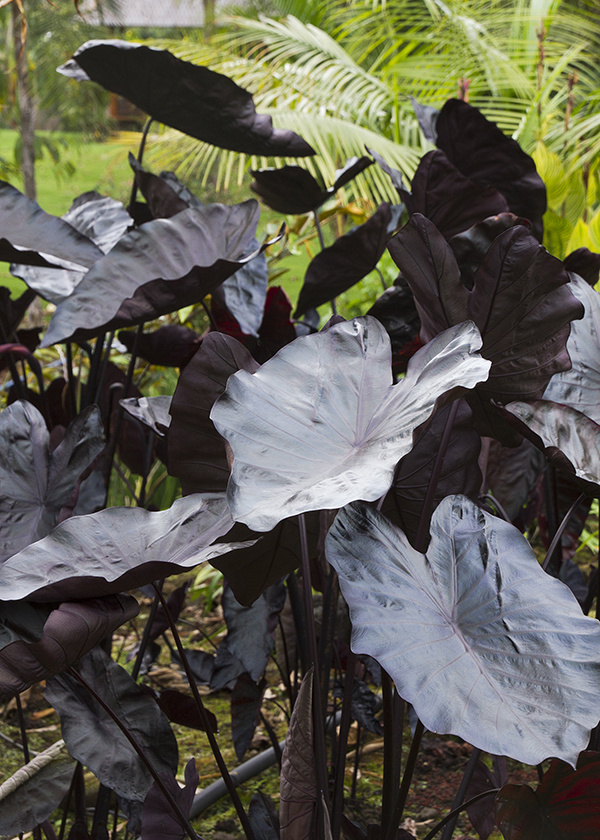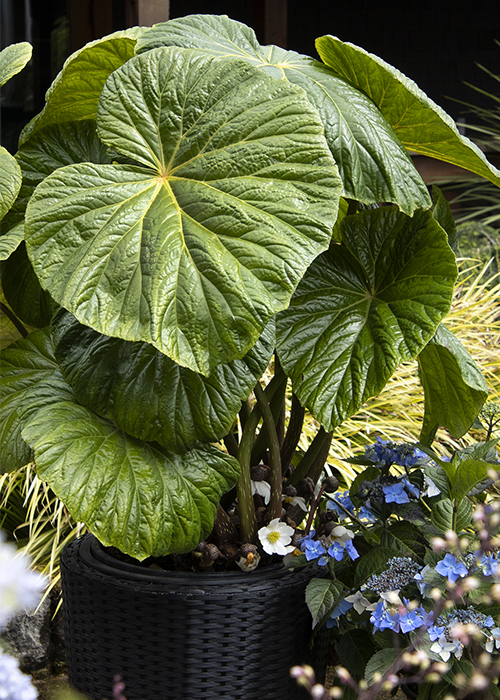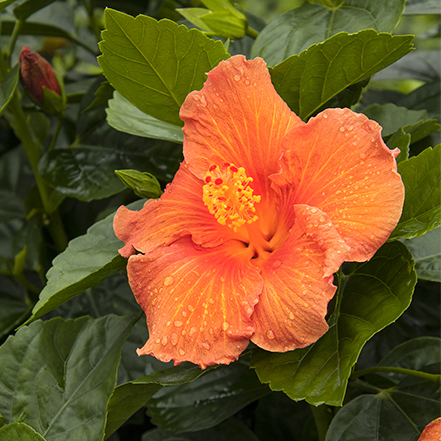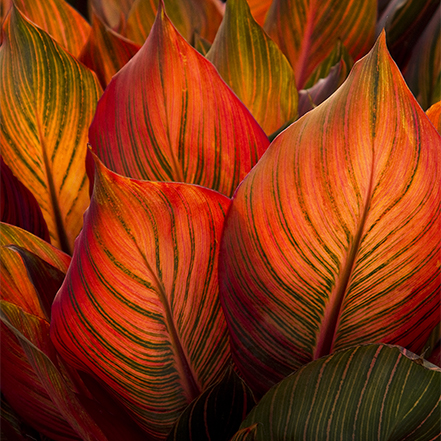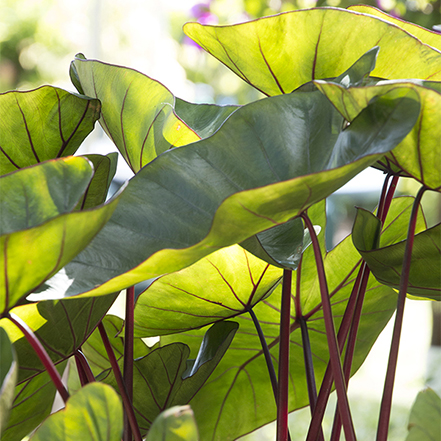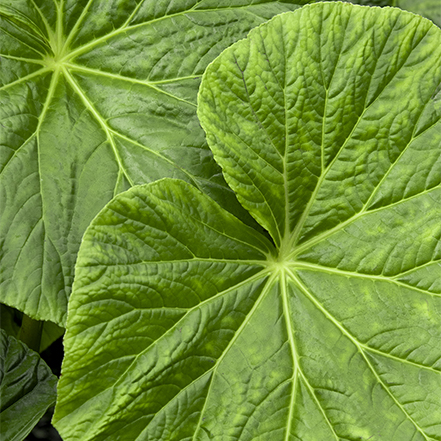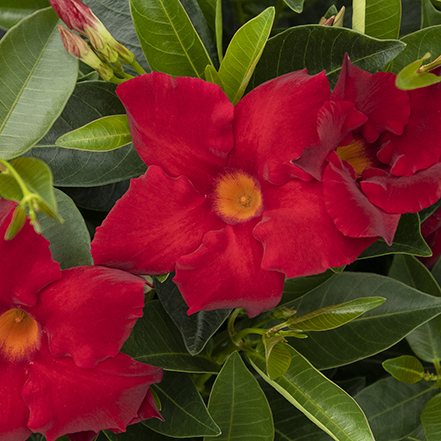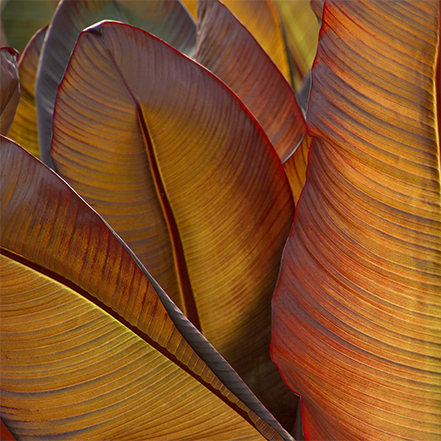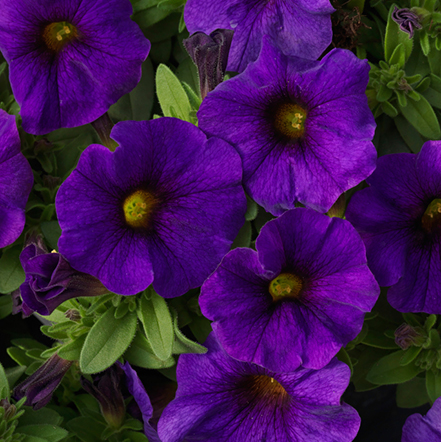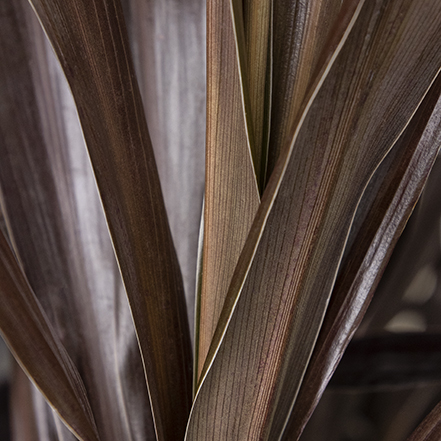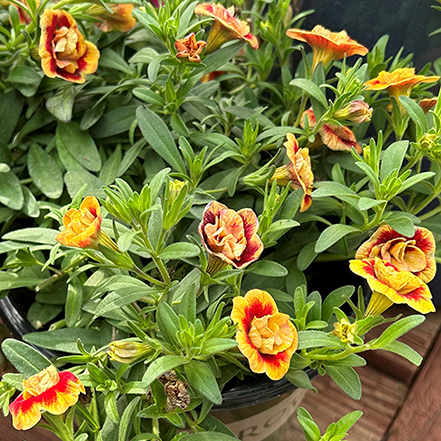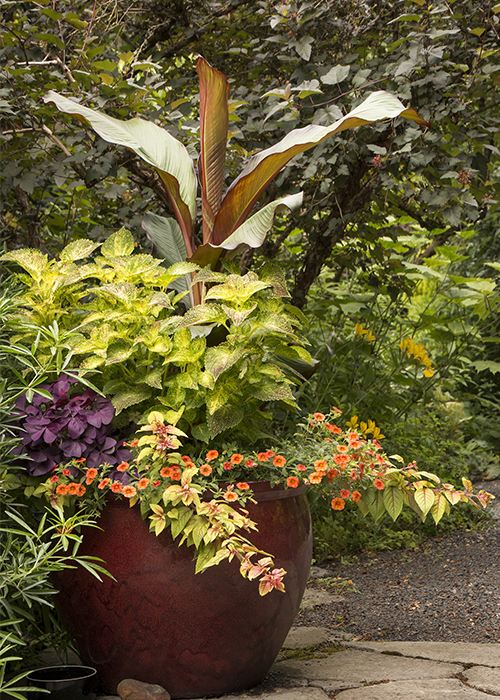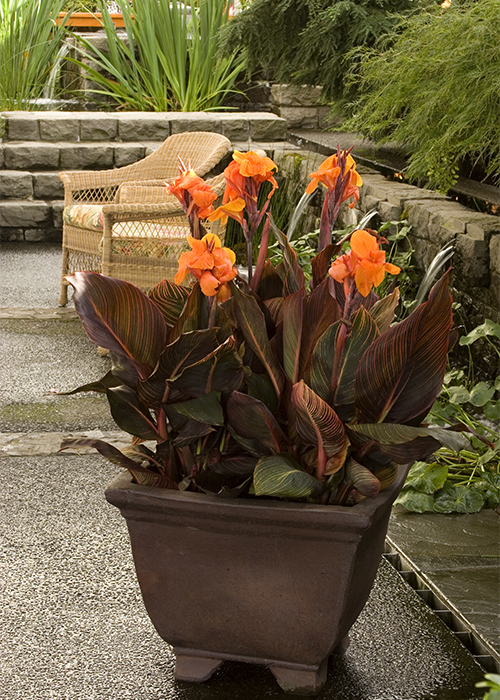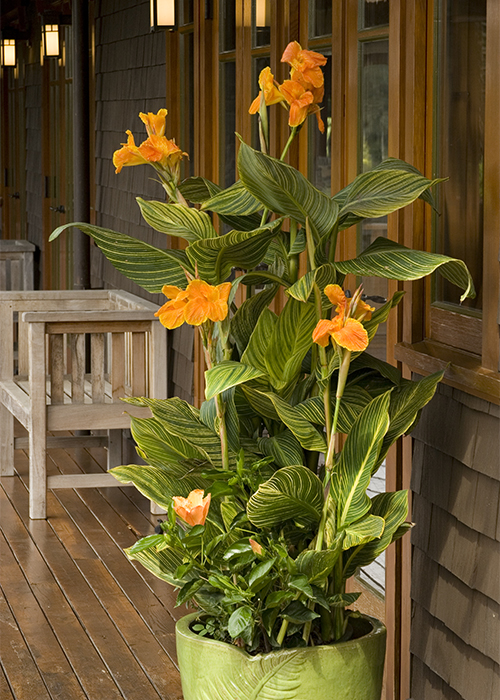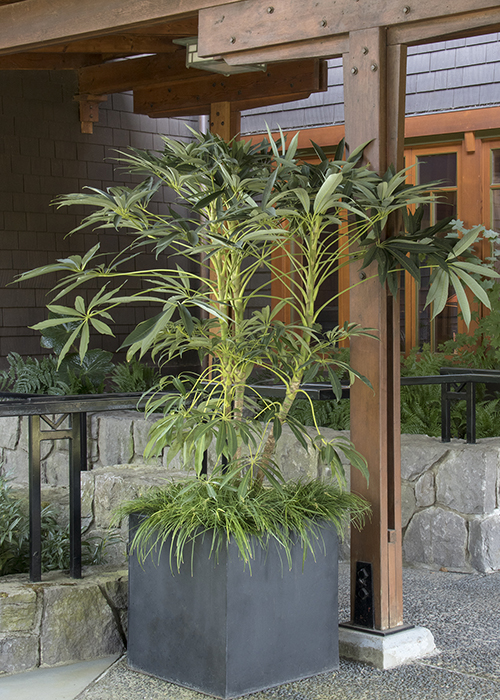Have you ever wanted to travel to a tropical oasis? Or perhaps you can’t get a previous excursion to paradise out of your mind. When you can’t hop on a plane to satisfy your craving for a lush and colorful tropical sanctuary, create your own.
It’s easy to craft the aesthetic that makes a trip to the tropics so special.
(Above) Royal Hawaiian® Black Coral Elephant Ear is a dramatic choice for patio containers, with striking glossy, jet-black foliage that adds bold, tropical flair to your outdoor space.
The secret? An assortment of artfully arranged tropical plants in containers can magically transport you to paradise—macaws and geckos not required.
We’ve gathered some suggestions for what to plant and how to style your own paradise. Follow these tips to not only design a tropical-looking deck, patio, front entry or garden feature using containers but to also ensure your oasis survives and thrives all season long.
How to Select The Best Tropical Plants for Containers
A lush display of tropical plants isn’t necessarily confined to the environs of Miami or Malibu. The same aesthetic can also be created in Maine, Minnesota, and wherever winters are far from warm.
The key to success with tropicals anywhere and everywhereis knowing the general details of your climate and understanding the conditions where tropical plants thrive best.
Know your Hardiness Zone.The Hardiness Zone Map is based on the average annual minimum winter temperature. Plants are categorized by Zones in which they can survive. Tropical plants generally fall into Zones 9-11 (Zone 9 is an average annual minimum winter temperature of 20F-30F), with some being able to survive winter conditions in Zone 7 (an average annual minimum winter temperature of 0F-10F). The tropical plants you purchase may be able to survive outside with minimal protection if you are in Zones 7 or above. For tropical plants that you expect to stay in containers outdoors, be sure to select ones that are matched to your Zone.
Keep an eye on your weather. For those living in Zones 6 and below, know that your tropical plant experience has two options: You’ll either treat your tropical plants as you would other annual flowers (i.e. plant and enjoy for one season and then compost them come fall), or you’ll take measures to protect them over the winter (more on that to come). While tropical plants may be able to survive limited exposure to temperatures below freezing, cool temperatures (49F or below) can cause leaf damage and growth issues. You’ll be sure to pot up your tropical containers well after the in-the-40s nights have ended for the growing season.
Keep an eye on the light. Different tropical plants have different sun and shade tolerances. Be sure the plant’s needs and your light exposure match, otherwise you might have less-than-stellar plant performance.
Pro Tip! Zone 6-and-colder gardeners, purchase larger sizes of tropicals! You have a shorter growing season than warmer regions, so buying larger sizes is a smart way to create impact immediately. Smaller-sized tropical plants will stutter in their early-season growth and not come into their own until the end of summer. Save time and create a stunning full-sized look right away.
Favorite Tropical Plants for Containers
Now that you know about temperature limitations, sun and shade tolerances, and the perks of buying larger plants, it’s time to share a few tropical plant varieties that we think you’ll adore. Remember, the best performance you’ll coax out of your tropical beauties will happen when you provide them with all of the temperature, light, water, and soil preferences these plants require. That said, let’s show you a few of our favorites.
Jazzy Jewel® Hibiscus. This tropical hibiscus series produces tons of large, long-lasting, and colorful blooms that sit amid glossy, green leaves. A full-sun plant that tolerates moderate watering, Jazzy Jewel Hibiscus will reach 4 ft. tall in a container and bloom all summer long. Available in Amber, Gold, Opal, and Ruby. Zones 9-11.
Tropicanna® Canna. Canna is the essence of “tropical”, with both their foliage and flowers offering incredible island vibes. These full-sun/partial sun plants offer exotic foliage gem-like flowers Growing to a height of between 4-6 feet, Tropicanna®, Tropicanna® Black and Tropicanna® Gold are a go-to source for oasis creators. Zones 7-11.
Royal Hawaiian® Elephant Ear. Foliage high-fashion! The dark stems of Hawaiian Punch pop against its bright-green leaves, while Maui Gold’s chartreuse large “ears” are held aloft on ivory-white stems. These, along with the Black Coral featured above or Waikiki shown below, provide a dramatic choice for containers in full and filtered sun locations. Grows to 3-4 ft. tall. Zones 7-10.
Tectonic™ Begonia. Another instance of all the drama being in the leaves, Tectonic™ Begonias add that something special in tropical containers by way of their leaf shape. Each of the Tectonic™ Begonias—Magma, Shangri-La™ and Pangea are three distinctively different looks to consider—have leaves that will stop you in your tracks with their shape, color, and textural combinations. All are stars in their own rights, but their leaves can provide a backdrop against which others can shine, as well. Most grow to 12-18 in. tall and wide, but note the supersized growth habit (and impact!) of Tectonic™ Caldera, featured below. Zones 8-11.
Sunvilla™ Mandevilla. Like stars that twinkle in the night, the flowers of Sunvilla™ Mandevilla sparkle against the glossy-green leaves of this nearly 2-ft. long vining plant. The throats of Red, Giant Red and Pink all have bright yellow throats, prolonging that sense of sparkle. This is the choice for an instant tropical vibe! Zones 9-11.
Banana Plants. Classic container favorites for a reason, banana plants bring a lush and exotic aesthetic with large, vibrant leaves that create a dramatic focal point. Their fast growth rate ensures a quick and impressive transformation, even in zones with cold winters. Zones 10-11.
Jazzy Jewel®
Amber Hibiscus
Showcases abundant, striking soft-orange flowers that endure for extended periods. Its vibrant, glossy green leaves create a stunning contrast, making it a remarkable choice for vibrant, tropical gardens or for adding an exotic touch to containers in patios and courtyards. Full sun. Up to 5' tall and wide. Zones 9-11.
Tropicanna®
Canna
Magnificent, vibrant orange blooms rise gracefully on tall stems. Its exotic foliage adds intrigue, featuring emerging burgundy leaves that mature with captivating stripes of red, pink, yellow, and green. This dramatic specimen brings a burst of bold color and luxurious texture to containers. Full sun. Up to 5' tall, 4' wide. Zones 7-11.
Royal Hawaiian® Waikiki
Elephant Ear
Perfect for displaying in a large container, with glossy green and white foliage that has vibrant pink veins and dramatically dark stems. Bred to thrive both in gardens and containers, this resilient Colocasia series exhibits excellent disease resistance, earning it the prestigious All-American Selections (AAS) award for 2023. Partial to full sun. Up to 3' tall and wide. Zones 7-11.
Tectonic™ Caldera
Begonia
Boasting massive, glossy, heart-shaped leaves, this plant starts off with striking red foliage that unfurls into a vibrant shade of green. Originating from northeastern India, it is known for its exceptional size, with leaves reaching up to an impressive two feet in width! Partial shade. Up to 6' tall and wide in the landscape, smaller in containers. Zones 8-11.
Sunvilla™ Giant
Red Mandevilla
Featuring extra-large red flowers complemented by a vibrant yellow throat, this robust tropical vine showcases exceptional color retention. Its glossy, green foliage adds to its allure as it gracefully climbs container obelisks or trellises. Treat as annual in cooler regions. Full to partial sun. Twining stems reach up to 20' long. Zones 9-11.
Red Leaved
Banana
Perfect for large, tropical patio containers, this stunning palm-like plant boasts huge, broad leaves that fan out from a single trunk. Bold-colored foliage has wine-red and bronze tones with prominent venation. Quickly reaches up to 15' tall, 10' wide, and smaller in containers. Partial to full sun. Zones 10-11.
Creative Container Ideas and Plant Combinations
It’s time to imagine what you can do with these and other tropicals you’ve fallen for within Monrovia’s collections. While creativity is in the hands of the doer, we’re happy to start you on your tropical container creation journey with a few ideas.
Add in some annuals
Use colorful annuals around a tropical foliage plant to add seasonal pops of color. A Superstar Cordyline underplanted with pink, purple, or orange Impatiens, SuperCal® Petchoa, or Calibrachoa can accentuate the color of its wine-red leaves.
Minifamous® Neo Double
OrangeTastic Calibrachoa
A colorful annual that blooms spring until frost. Fun double blooms are yellow on the outside and deep orange on the inside. Forms a dense mound with a semi-trailing habit, perfect for mixed containers or hanging baskets. Flowers are loved by bees and butterflies. Full sun. Up to 12" tall, 15" wide.
Use the “thriller, filler, spiller” design concept
This is the no-fail, 3-step method of planting an eye-catching container:
- Plant a “thriller,” i.e. something tall, either in the middle or along the back of your container.
- Use a “filler,” i.e. a mid-sized and mounding plant in front or around the thriller.
- Include a “spiller,” i.e. a plant that cascades down the side of the container.
This design method leads the eye through the multiple layers and elements of the container. For example, a tropical “thriller, filler, spiller” container could have a red-leaf banana as the thriller, mounding coleus and purple oxalis as the fillers and any number of hot-hued cascading annuals such as calibrachoa.
Match your pots to your plants
Vary container sizes in sets of three
The “thriller, filler, spiller” concept can be deconstructed and expressed in three separate containers of different sizes. For example, a small-sized container may contain a Tropicanna Gold as the thriller, a taller container could hold a Tectonic Shangri-La as the “filler,” and a St. Elmo’s Fire Firecracker Plant can act as the “spiller” in a medium container.
Tropicanna® Gold Canna in a small-sized pot can act as a “thriller” when combined with fillers and spillers in different pots.
How to Choose the Right Container for Your Tropical Plants
Aside from color to match your décor or to highlight your tropical plants, several considerations go into choosing the appropriate containers for tropicals.
Size. The larger the plant, the larger your container should be. Siam Ruby Banana, for instance, grows to 8' tall, and the Winged Phoenix™ Hardy Schefflera pictured here can get up to 15' tall if it has enough space. It needs to be in a larger and heavier container that will ensure the plant is stable and won’t tip over.
Aesthetically, a plant should look as though it “fits” the container appropriately, similar to how a suit should fit the person wearing it. For tropical combination plantings, the volume of the container should comfortably hold what is planted within.
Drainage. Containers should have one or several drainage holes. This allows excess water to drain from the potting soil, ensuring the plants’ roots aren’t too wet. If your favorite or must-have containers do not have drainage holes, then be sure to use a pot-in-pot technique. That is, place the plant and its nursery pot with drainage holes into a slightly larger hole-free decorative container. The nursery pot will drain excess water into the larger container. In this case, you will need to occasionally pour out the excess water from the container.
Style. There are as many styles and types of containers as there are tropicals to plant in them! Keep in mind that terra cotta pots are porous and will dry out faster than glazed pottery and will need watering more frequently. You can also find self-watering containers that will lessen the pressures of keeping up with your plants’ watering needs. There are plenty of styles and sizes on the market and you’ll definitely find something that suits your aesthetic.
You might prefer creating a “container” out of a woven basket, a decorative bucket or old metal drum. If shabby chic is your style, you’d again use that pot-in-pot technique where the plant remains in its nursery pot and the other pot is for décor purposes.
Care for Tropical Plants in Containers
You want your tropical oasis to look great when you create it and beyond. Caring for your plants’ needs as you pot them up and as they grow will help ensure their health and happiness for months and even years to come.
Your first step will be to provide your plants with the growing requirements listed on the plant tag or in its description. The care information on Tropicanna® Canna, for instance, calls for nutrient-rich, consistently moist soils and placement in full sun. Do that!
As a general rule, fertilize your tropical plants with a balanced fertilizer (e.g. 10-10-10 Nitrogen-Phosphorus-Potassium ratio) every two weeks while they are actively growing. If your tropical plant has just started to form flower buds, you can encourage more blooms by providing it with a fertilizer higher in Phosphorus (e.g. 5-10-5).
The best way to notice if anything is going awry with your tropicals is to actively notice them every few days. An occasional yellowing leaf is common—just snip it and remove it. But are leaves routinely yellowing? Do they have brown spots or moist spots? Could the browning be from too much sun?
Common issues with tropical plants can be addressed with a watchful eye and regular maintenance. The problems you’ll encounter most with tropicals grown in the great outdoors are too much water, too little nutrients, inappropriate sunlight and pests. Pests are masters of concealment! Turn over and unfurl curled leaves and pay particular attention to petioles and leaf junctures and look for white or grayish fuzz (mealy bugs!), bright yellow eggs (aphids!), webbing (mites!) and sooty-looking mold (scale!). All of these pests can be eradicated with a series of treatments as soon as you spot them. The key, as we said, is to check your plants regularly.
Overwintering and Protecting Tropical Plants
For those of you gardening with tropicals in Maine, Minnesota, or other places that aren’t kind to warm-climate plants in cold weather, remember we mentioned there are options for overwintering these tender perennials.
Tropical foliage plants commonly do double duty in the market as “houseplants” anyway. Bring your begonias, bananas, elephant ears, and other leafy lovelies indoors once the outdoor temps fall below 55F. They will return the gift of your warm refuge with their lush, naturally looking tropical vibe.
It’s relatively easy to bring them into your home—just treat them for pests, repot them if necessary, and place them in your most beautiful indoor decorative pots (or go shopping for some new ones!).
Flowering tropical plants, such as hibiscus, mandevillas, jasmine, and cannas, can be kept indoors as houseplants, as well. These can be a bit trickier to maintain inside, but the secret is to provide the brightest, sunniest windows you can find. To coax these bloomers into flowers, prune them a couple of times between fall and spring and you just might get a flower or two.
Our post on how to overwinter tropical plants indoors has more details on how to bring foliage and flowering tropicals indoors safely and set them up for a cozy winter ahead.
Treated with just the right care, your tropicals will be recreating your favorite places of paradise inside and out for years on end.
Learn More About Container Gardening
- Check out the Containers section of the Be Inspired Blog.
- Sign up for our Grow Beautifully newsletter. You'll get more design inspiration, garden tips, how-tos, and first access to exclusive guides, webinars, and plants.
- How to Overwinter Tropical Plants Indoors
- Beat the Heat with Succulent Container Combos
- Colorful Pollinator Container Ideas
- Best Container Plants for Full Sun and Heat
- "Vacation Proof" Container Combo Ideas





